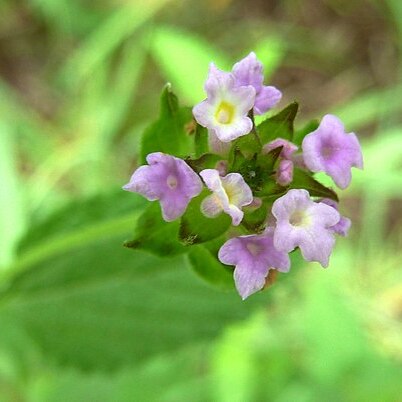Leaves opposite, rarely 3-whorled, petiolate, mostly shorter than the internodes; 0.7–5.5(7.5) × 0.5–4 cm, ovate, oblong-ovate or lanceolate, sometimes broadly ovate, acute, rounded at the base and cuneate into the petiole, closely crenate or crenulate on the margins with 9–15(18–21) shallow teeth on each side, strigose with whitish tubercle-based hairs on the upper surface, becoming scabrid with the tubercle-bases persisting in older leaves, densely shortly whitish hispid beneath and with minute sessile reddish glands on the lower surface, rugose with impressed venation above, ± strongly raised-reticulate beneath; petiole up to 8 mm long.
Aromatic shrub, up to 1 m high; much branched, woody; stems and branches 4-angled, strigose. Leaves petiolate; lanceolate, ovate or oblong-ovate, apex acute, base rounded to cuneate into petiole, margins crenate; profusely punctate glandular, strigose on upper surface, densely shortly whitish hispid beneath. Inflorescence: spikes subspherical or ovoid; lower bracts ovate-lanceolate to broadly ovate. Flowers pale rose, lilac to red-purple or violet with yellow throat, rarely white. Calyx appressed-pilose, thinly membranous. Corolla: tube dilated about middle; lower lip 3-lobed. Flowering time Aug.-May. Fruit drupaceous, purple, pulp edible.
Much-branched shrub, up to 1 m high; densely, shortly pubescent. Leaves petiolate; blade ovate to narrowly ovate, 7-55 x 5-40 mm, apex acute, margins closely crenate or crenulate with 9-15 shallow teeth on either side; petioles up to 8 mm long. Flowers: in elongate spikes; lowest bracteoles larger than rest; calyx ± as long as corolla tube; corolla with tube 3-4 mm long, swollen in middle, pink to mauve; Sep.-Jun. Fruit a drupe, 2.5-3.5 mm long, purple or wine-coloured on ripening.
Corollas ± exceeding the bracts, pale rose, lilac to red-purple or violet with yellow throat, rarely white; tube (3)3.75–4 mm long, ± swollen about the middle, shortly puberulous; lower lip c. 3.5 mm broad, 3-lobed, the lobes rounded, the median one c. 2 × 1.5 mm, larger than the lateral ones.
Peduncles solitary in leaf axils, ascending-erect to ± spreading, 1.5–6 cm long at anthesis, 7(10) cm long and becoming rigid in fruit, mostly more than half as long as the subtending leaf or up to c. 3 cm longer than it, slender; indumentum similar to that on the branchlets.
Stems and branches 4-angled, ± softly strigose and more densely so toward the apices, the indumentum with hairs ± tubercle-based and usually curving appressed antrorse, sometimes somewhat spreading, with sessile glands intermixed.
An erect shrub. The stems and leaves have a smell. It grows up to 1.8 m high. The leaves are rough. The flowers are pink. They are clustered at the ends of stems. The fruit are purple.
Shrub, up to 2 m high, densely shortly pubescent. Inflorescence elongate, spicate. Lowest bractlets larger than the rest. Flowers pink to mauve.
Calyx ± as long as the corolla tube, appressed-pilose, ciliate on the margins, thinly membranous.
A much branched shrub up to 2 m tall, or sometimes a woody perennial 45–90 cm tall.
Drupes 2.5–3.5 mm long, purple or wine-coloured on ripening.
Stamens inserted ± at the middle of corolla tube.

